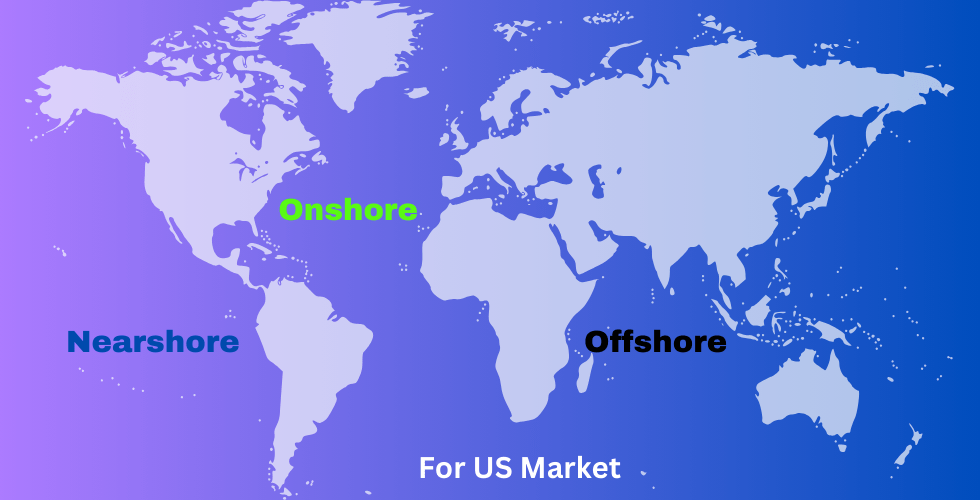What Are The Types Of Software Outsourcing?
Software outsourcing can take various forms, each with its own advantages and disadvantages. According to the research of Technavio The IT outsourcing market share is expected to increase by USD 117.24 million from 2021 to 2026, at a CAGR of 4.12%.

1. Onshore Outsourcing
Onshore outsourcing involves hiring a software development team within your own country. It offers close proximity, cultural alignment, and minimal time zone differences. But, it can be costly.
Projects that are best for onshore development are ones where people need to work together in person a lot. Where there are strict rules about where the developers can be located or privacy. Or where there are in-person development requirements.
2. Offshore Outsourcing
Offshore outsourcing means hiring a software team from a distant country. It’s cost-effective but can come with communication challenges due to time zone differences.
For offshore development, it’s good for tasks that are repetitive and not automated. Like IT support work, and projects that don’t need a lot of close teamwork or quick changes. Also, it’s suitable for projects that won’t be affected much if the team changes often.
3. Nearshore Outsourcing
Nearshore software outsourcing strikes a balance between the two. You collaborate with a software team in a nearby country, reducing costs while maintaining ease of communication.
Best-Suited Projects for Nearshore Outsourcing
- B2B, B2C, and SaaS Solutions:
Creating software for businesses or direct customers, especially when collaboration is needed.
- Real-time Collaboration (Not Face-to-Face):
Projects where people need to work together instantly but don’t have to be in the same physical location.
- Agile Approach:
Tasks that benefit from a flexible and iterative development process.
- Strategic and Complex Projects:
Projects that are not straightforward and require ongoing discovery and teamwork.
- Development of New Software Solutions:
Creating entirely new software applications or systems.
- Modernization of Complex Legacy Software:
Updating and improving older, intricate software systems.
get in touch to discuss your project
What is Nearshore Software Outsourcing?
Nearshore software development is when you hire a team of software developers who are not too far away from you, usually just 2-4 hours away by travel. It’s a good option, kind of like the second-best choice, after hiring experts in your own country. You still get high-quality tech experts, but it’s often less expensive than keeping everything in your own country.
The Fundamentals of Nearshore Software Outsourcing
Key Benefits
Nearshore development offers several benefits that can be advantageous for businesses and organizations.
Cost Savings:
Nearshore development often provides cost advantages compared to onshore development. While the rates may not be as low as offshore development in distant countries. They are generally more competitive than domestic rates. That can help you save money on development projects.
Cultural Compatibility:
Nearshore teams are typically located in neighboring or nearby countries. They often share similar cultural aspects, time zones, and work ethics. This cultural compatibility can lead to better collaboration and understanding between your team and the nearshore developers.
Language Proficiency:
When working on a project, it’s helpful if everyone can speak the same language because it makes communication much easier. When you hire a team or a company from a nearby country, it’s easier to communicate because you probably speak the same language. So there are no language barriers to worry about.. And that’s a big advantage for getting the project done right.
Proximity and Time Zone Alignment:
Being in relatively close geographical proximity, nearshore teams can work in the same or similar time zones as your business. This enables real-time communication, easy coordination, and faster response times.
High-Quality Talent:
Nearshore regions often have a pool of highly skilled and educated professionals who can provide top-notch software development services. You can tap into this talent pool without the need for extensive recruitment efforts.
Intellectual Property Protection:
Many nearshore countries have robust intellectual property laws and data protection regulations. They provide a higher level of security for your projects and sensitive information.
Time-to-Market Acceleration:
With efficient communication and collaboration, nearshore development can help expedite the development process. It allows you to bring your products or solutions to market more quickly.
Scalability and Flexibility:
Nearshore development teams are often well-equipped to scale up or down quickly based on your project needs. They normally offer flexibility that can adapt to changing requirements.
Cultural Alignment:
Nearshore partners often share similar cultural norms and values. This makes it easier to align project goals and expectations. This cultural synergy fosters smoother collaboration.
Regulatory Compliance
Countries that are nearshore usually have strict rules and laws to keep your projects safe. So, when you hire a team of programmers from a nearby country, you can trust them. I would suggest to check their privacy laws before hiring.
In summary, nearshore development can be a smart choice for businesses looking to balance cost-effectiveness with high-quality development. With efficient communication, and reduced operational risks. It allows you to leverage the benefits of global talent while maintaining proximity and alignment with your business objectives.
get in touch to discuss your project
How Does Nearshore Development Work?
- Define Your Project:
Clearly outline your project requirements and objectives.
- Research Vendors:
Research and shortlist Nearshore development companies based on expertise and experience.
- Request Proposals:
Reach out to selected vendors for project proposals.
- Evaluate Proposals:
Compare proposals, taking into account cost, expertise, and timeline.
Select the vendor that aligns best with your needs.
- Communication Plan:
Establish a robust communication plan to bridge geographical gaps effectively.
- Onboard the Team:
Set up communication channels and project management tools.
Draft comprehensive legal agreements that outline project scope, responsibilities, and confidentiality clauses.
- Monitoring and Feedback:
Put in place a monitoring system to track project progress and provide feedback to improve outcomes.
When you hire a nearshore development company from the US, they often offer insurance to protect your project. This insurance is not always common in Latin America, where many of the developers are located.
There are two main ways to work with nearshore developers:
- Integrated teams: This is when you add a few developers from Latin America to your existing team. You guide these new team members, and you’re responsible for the project’s success. You pay based on how much time and effort they put in.
- Dedicated teams: With this approach, you get a whole team of developers who already know how to work together effectively. They’re ready to start working on your project right away. You pay a fixed monthly fee for the whole team, making it easier to budget. These teams are often good at delivering results quickly.
Both approaches have their advantages, but dedicated teams can be more efficient and provide a smoother experience, especially if you need to get things done quickly.
How To Choose A Nearshore Software Outsourcing Region
Before you decide on a company to do software work for you from a nearby country, take a look at that country first. Look for signs that they have good digital skills education, good technology, and can speak English well. Latin America is a popular place for this kind of work, and they have a good education for digital skills. They’re also close to the United States and can speak English pretty well. You should also check if the country is known for being good at doing business and if the government supports this type of work. Once you’ve picked a country, then you look at the companies there. A good one will show that they use modern ways to make software and have worked well with other companies for a long time. Right from the start, you should focus on making sure the software they make is good quality and works well. Talking openly with them is important, and if you do that, you’re more likely to have a long-term partnership with them.
Nearshoring, like any business strategy, comes with its share of risks. Here are some common risks associated with nearshoring:
Quality Concerns:
Depending on the nearshore provider you choose, there may be variations in the quality of work. In some cases, the quality may not meet your expectations, leading to project delays or rework.
Communication Challenges:
Although nearshore teams are geographically closer, language barriers or differences in communication styles can still exist. Miscommunication can lead to misunderstandings, affecting project outcomes.
Time Zone Differences:
While nearshore locations are usually in similar time zones, there may still be time differences. If not managed properly, these differences can lead to delays in communication and project progress.
Cultural Differences:
Despite geographic proximity, cultural differences can exist, affecting how teams collaborate and work together. It’s essential to address and manage these differences to ensure effective teamwork.
Data Security:
When sharing sensitive data or intellectual property with a nearshore team, there can be concerns about data security and intellectual property protection. It’s crucial to establish robust security measures and legal agreements to mitigate these risks.
Political and Economic Instability:
In some nearby places where you might hire help. There can be problems with the government or the economy that make your outsourcing partner less reliable. If the government changes rules or the economy gets shaky, it can affect how much it costs and if you can still get the help you need. Vendor
Reliability:
The reliability of your nearshore service provider is crucial. f they have money problems, new people in charge, or other troubles, it can mess up your projects and how your business keeps running.
Hidden Costs:
While nearshoring can be cost-effective, there may be hidden costs related to travel, legal compliance, or unexpected project requirements. These costs should be factored into your budget and planning.
Lack of Control:
When outsourcing, you may have less direct control over the development process compared to an in-house team. This lack of control can be a risk if the vendor’s performance does not meet your expectations.
Legal and Regulatory Issues:
When the rules and laws in your country don’t match up with the rules in the nearby place you’re working with. It can create problems. These problems might involve following the law and making sure contracts are fair and square.
Comparative Chart of Onshore Nearshore and Offshore Software Outsourcing
| Standard | Onshore | Nearshore | Offshore |
| Cost | High $50+ | Average $25-$100 | Low to High $10- $100 |
| Real-Time Collaboration | Same time | 2-3 hours difference | 8+ hours difference |
| Travel | – | 2-4 hours flight | 8+ hours flight |
| Quality | High | Medium to High | Medium to High |
| Culture | Same | Near to same | Different |
| Language | English | Moderate to low proficiency across Latin America | Very Low to High across Europe and Asia |
| Security | Excellent | Good | Fair |
| Risk | Low | Medium | Low to High |
Source: hatchworks.com, turing.com and others



















